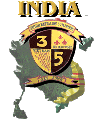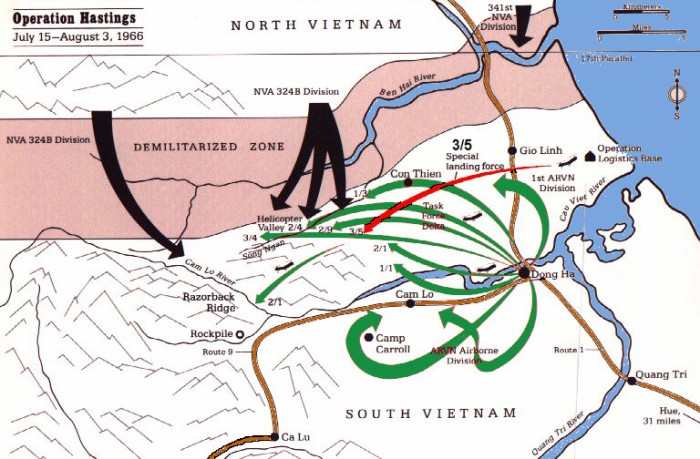www.operationhastings.com


The men of India Company who fell on July 24, 1966
LCPL
ROBIN L.
ARNOLD
PFC
RANDY
BROSNAN
LCPL
RONALD
COATES
LCPL
GEORGE
COREY
PVT
OSCAR
CRUZ
CPL
RICHARD
CURRIER JR
PFC
LAWRENCE
DANIELS
PFC
LAWRENCE
DENNY
PFC
FRANKLIN
EUCKER
PFC
R.
FENSTERMACHER
SSGT
JERRY
HAILEY
PFC
DANIEL
HARMON
SSGT
WILLIAM
HAWKINS
CPL
ROBERT
JOHNSON
PFC
STEPHEN
KITTLE
1LT
JOSEPH
KOPFLER III
LCPL
SIDNEY
MALONE JR
PFC
THOMAS
PRESBY
Rest in Peace, heroes
|
In May of 1966, a small band of North Vietnamese Army regulars made their way across the DMZ into Quang Tri Province to begin preparing for a massive invasion by ten thousand troops of the NVA's 324B Division. The invasion would begin in late May after the local sympathizers and the recon platoon were charged with readying the battlefield with supplies, including food. Led by General Nguyen Vang, the invasion by the 324B began in the last week of May. But soon, Vang realized his supplies were not in place, thanks to the ineptness of the VC. The Division stalled itself on the banks of the Ben Hat River while the General sent troops back to North Vietnam for supplies. Meanwhile, General Westmoreland began receiving information about the presence of the 324B. He had long suspected that the NVA would attempt an invasion into Quang Tri and had so informed President Johnson as early as February. Now recon photo's, intelligence and even a captured NVA soldier had confirmed the buildup of the NVA's 342nd. But even with the mounting evidence, Westmoreland waited for more intelligence. He felt that an all-out counterattack was premature without Marine reconnaissance information. But the Marine commanders, though concerned with the buildup at the DMZ, believed that it was not in preparation for an invasion. The 324B's presence, they believed, was an attempt to lure the Marine forces to the area and weaken the Da Nang stronghold. But Westmoreland, growing tired of the Marine commander's position, finally ordered General Walt to send reconnaissance into the area and determine the purpose and scope of the NVA 324B. On July 1, 1966, a Marine recon unit of 12 men lifted off from Dong Ha and were dropped near two intersecting trails in the DMZ. Immediately, they were overwhelmed with fire from the NVA and were hurriedly airlifted back out. Over the next two weeks, they landed in several locations. They spotted hundreds of NVA regulars, mortar placements, trench lines, fortifications and foxholes. It was now apparent to Westmoreland that the NVA had crossed the DMZ, an unprecedented event . Orders went out to General Walt: Seven Marine Infantry Battalions and Five ARVN Infantry and Airborne Battalions (over 11,000 men) would be reinforced by artillery and aircraft as well as the long-range guns of the U.S. 7th Fleet. Operation Hastings, the largest Marine operation ever undertaken, had begun. The field of operations in Quang Tri was varied but almost half of the Province was mountainous jungle. A jungle which had a canopy so thick that bombs couldn't penetrate it. To the east, the mountains gave way to foothills and then a thin stretch of paddy land followed by sandy beaches in the coastal regions. Commanding Hastings was Brigadier General Lowell English. His plan was to cutoff the 324B by taking control of two trails just south of the DMZ. A key point in this plan was the placement of Marines on top of the "Rock Pile", a craggy hill overlooking the Cam Lo River and the flat plains to the north. With such a massive deployment of troops, the NVA could surely see the dust rising out of nearby Dong Ha as US planes continuously landed with supplies and troops. Then, for three days, B-52's began dropping bombs on NVA positions. On July 15th, Operation Hastings began with the airlifting of troops into an area called "Helicopter Valley". Marines from the 3/4 landed in peace on the first drop but it was short lived. The second drop was answered with sniper fire and soon the marines were taking heavy fire. By the third drop, things were going bad. Helicopters collided and marines were dying. Soon, the Marines of the 3/4 were cutoff behind enemy lines and were taking a pounding that lasted for days. It was the bloodiest battle of the operation.
Operations Hastings Map from the Hastings History Page. The red arrow is the movement of India 3/5 into the battle area. On July 24th, India 3/5 was ordered to proceed to the top of Hill 362 and establish a radio relay station. The station was necessary due to the mountainous terrain and the need to be able to communicate with troops within the Helicopter Valley and Rock Pile regions. India Company made their way to the Hill and began securing the outlying trail when it was ambushed by a large force of NVA. Heavily hit, the men of India remained on top of the hill throughout the night protecting it and their wounded. At dawn's light, the carnage was apparent. Finally, the wounded could be evacuated while skirmishes continued throughout the next day. For a description and account of what happened to Tink on Hill 362, please click here. A word of warning, this is a graphic account of the fighting that was going on. PVT Joe Holt, who was on Hill 362 that day, has also written a graphic account of the battle. Click here for that account. Lt. Sam Williams was leading the Platoon that Tink was in at the time. Williams later wrote home to his wife, giving an account of the battle. The battles of Operation Hastings lasted throughout the month of July until the NVA abandoned their plans for an invasion of Quang Tri. Pulling back to North Vietnam, they had left 882 of their soldiers dead and 17 captured. They lost hundreds of weapons and tons of ammunition. There was a stiff price to pay for the Marines, though. 126 had been killed and 448 wounded in the three weeks of the operation. The operation ended on August 3rd, 1966. Accounts: |
